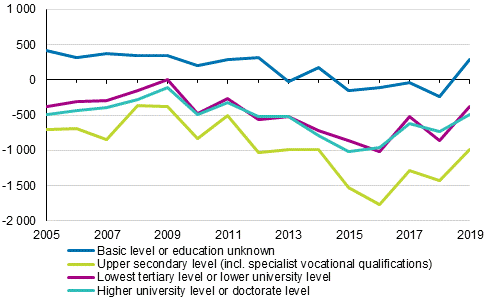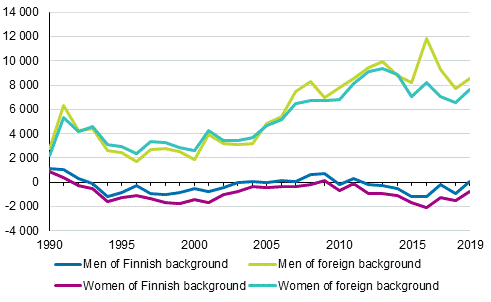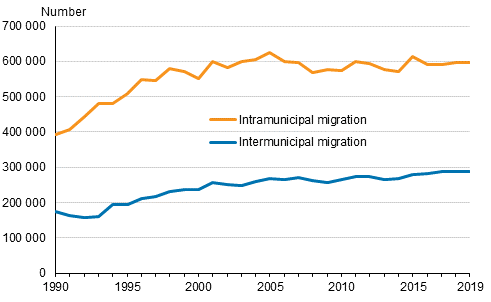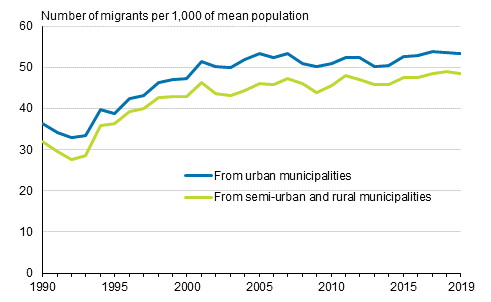Published: 21 December 2020
Migration loss of Finnish citizens has decreased in all educational groups
The net immigration of Finnish citizens has been negative in the 2010s, but during 2016 to 2019, migration loss has decreased clearly. The trend has been falling in all educational groups, especially among those with upper secondary level and at least higher university level qualifications.
According to Statistics Finland's data on population changes, the net immigration of Finnish citizens was 1,456 moves negative in 2019. Altogether 10,036 Finnish citizens moved abroad from Finland and 8,580 Finnish citizens moved to Finland. Migration loss has decreased from 2016, when the number of emigrations of Finnish citizens was as much as 4,079 higher than that of immigrations. From 2016 to 2019, immigration among Finnish citizens has grown by 12 per cent and emigration has decreased by 14 per cent.
Net immigration of Finnish adult citizens by level of education in 2005 to 2019

The net immigration loss among adult Finnish citizens has decreased in all educational groups in recent years. In 2016, there were around 1,000 more emigrations than immigrations in the groups with lowest tertiary level or lower university level and at least higher university level education, but by 2019, the loss had diminished to around five hundred in both educational groups. Among completers of upper secondary level education, migration loss was nearly 1,800 in 2016 but has since decreased most, to just under one thousand in 2019. The net immigration of persons with basic level education or unknown education became positive last year.
The immigration of adult Finnish citizens has increased in all educational groups during 2016 to 2019. The growth has been biggest for those with higher university or doctorate level degrees, 24 per cent. Among those with lowest tertiary level or lower university degrees and those with upper secondary level qualifications, immigration increased by 14 per cent during 2016 to 2019.
During 2016 to 2019, emigration decreased in all educational groups. The drop was biggest for those with basic level education, 23 per cent, and for those with lowest tertiary level or lower university level education, 20 per cent.
Finland’s migration gain from persons with foreign background
Finland's net immigration has been positive for a long time. In the 2010s, the number of immigrations has yearly been around 12,000 to 17,000 higher than the number of emigrations. Examined by origin, migration gain has in the past decade been formed almost entirely or entirely from the positive net immigration of persons with foreign background. In 2019, the net immigration of persons with Finnish background was 700 moves negative and that of persons with foreign background 16,200 moves positive.
The largest background country group in immigration of persons with foreign background was the former Soviet Union (2,400 immigrants). The next largest groups of immigrants were those with Estonian background (1,484), Indian background (1 448) and Iraqi background (1,368). Net immigration was highest in the background country group of the former Soviet Union (1,650), those with Iraqi background (1,154) and those with Indian background (1,055).
Net immigration by origin in 1990 to 2019

For women with Finnish background net immigration has been slightly negative for just under three decades. The loss has been about 100 to 2,100 moves annually. For men with Finnish background, the number of emigrants and immigrants has been equal at times, but during 2012 to 2018, for example, the number of emigrants exceeded immigrants annually by several hundred or good one thousand. In 2019, the net immigration of women with Finnish background was around 800 moves negative and that of men with Finnish background 87 moves positive.
The net immigration of men and women with foreign background has been fluctuated since the late 1990s, but after 2012, the growth in migration gain has slowed down somewhat for men with foreign background and slightly decreased for women with foreign background. For both sexes, net immigration was around 8,000 in 2019.
More information about immigration and emigration by origin can be found on the thematic pages on Immigrants and integration .
Internal migration on level with previous years
Intermunicipal migration has been growing steadily since the 1990s. By 2019, the number of intermunicipal migrations has risen to nearly 300,000. However, the number was slightly lower than in the two previous years, that is, the growth has evened out in the short term. The numbers of intramunicipal migrations have been relatively permanent since the beginning of the 2000s. During that period, the number of migrations has been around 570,000 to 620,000 per year. In 2019, intramunicipal migrations numbered around 596,000.
Internal migration within Finland in 1990 to 2019

Relative to the population, intermunicipal migration has also been growing briskly in the long term. However, the growth has evened out slightly since 2000. Typical for the period is a slightly rising trend fluctuating according to economic cycles. In 2019, the number of moves decreased slightly relative to the two previous years, being around 52 moves per one thousand persons. Examined by municipality group, it can be seen that migration propensity from urban municipalities has been slightly higher than from semi-urban and rural municipalities.
Out-migration propensity in Finland in urban, semi-urban and rural municipalities in 1990 to 2019

Internal migration concerned urban municipalities
Internal migration has mainly been directed to urban municipalities both for people with Finnish and foreign background. Migration gain relative to semi-urban and rural municipalities has grown steadily in urban municipalities since the beginning of the 2000s, reaching the high figures of the mid-1990s in recent years. At the beginning of the millennium, the migration gain of urban municipalities fell suddenly, after which the migration gain has risen to the level of the 1990s in approximately 20 years. However, the number fell slightly in 2019 from the year before.
Total net migration of urban municipalities and net migration by persons’ background country in 1990 to 2019

The total migration gain of urban municipalities has been sustained by the high immigration of persons with foreign background relative to emigration. For persons with Finnish background, emigration has in turn been higher than immigration in urban municipalities, which has in part lowered the overall migration gain of urban municipalities.
Net migration to urban municipalities evened out in several age groups
Among age groups, the biggest cause for migration gain in urban areas is student-age persons (aged 15 to 24). Their net migration has remained fairly stable for the past 15 years, being around 11,000 persons per year. Examined by age group, the growth in the migration gain of towns in the past few decades has been mostly caused by the growth in net migration in other age groups.
Net migration in urban municipalities in the 0 to 4, 5 to 14, 25 to 44 and 45 to 64 age groups in Finland in 1990 to 2019

Changes in net migration have been relatively significant among young children and working-age adults, even though the number of moves has been lower than among students. Among the 25 to 44 and 0 to 4 and 5 to 14 age groups, migration loss to urban municipalities has decreased relatively evenly since 2011 and for those aged 5 to 14 it turned into migration gain already from 2014 onwards (Figure X). However, migration to urban areas in these age groups has evened out slightly over the past three years. In 2019, net migration decreased for those aged 25 to 44 and 0 to 4 compared with the two previous years. In 2019, migration loss in urban municipalities was 1,900 persons for those aged 25 to 44 and 720 persons for those aged 0 to 4, and migration gain was 370 persons for those aged 5 to 14.
Among age groups, migration loss in urban municipalities among those aged 45 to 64 has also decreased varyingly since 2003. In 2019, migration loss amounted to around 280, which is lowest for the age group in question during the whole measurement period.
Net internal migration of urban municipalities and out-migration propensity from semi-urban and rural municipalities to urban municipalities in Finland among persons aged 65 or over in 1990 to 2019

In addition to the previous age groups, the age group of persons aged 65 or over has had a clear impact on the clearly growing age group of the growing migration gain to towns. Their migration gain has been growing clearly since the beginning of the decade. The reason for the growth is not only the growing number of persons aged 65 or over, as out-migration propensity, that is, the number of immigrants per one thousand persons, has also been growing steadily in this age group from semi-urban and rural municipalities to urban ones. Compared to other age groups, the migration propensity and migration gain of those aged 65 or over are, however, fairly small. In 2019, the migration gain from internal migration among persons aged 65 or over was around 640 in urban municipalities, which is the highest number of the age group during the reference period. The migration propensity of persons aged 65 or over was slightly over four moves per one hundred thousand persons in 2019. However, the growth has been relatively significant for the elderly, this is a clear long-term growth trend.
Source: Migration 2019. Statistics Finland
Inquiries: Juhana Nordberg 029 551 3051, Joni Rantakari 029 551 3249, info@stat.fi
Head of Department in charge: Hannele Orjala
Publication in pdf-format (282.8 kB)
- Tables
-
Tables in databases
Pick the data you need into tables, view the data as graphs, or download the data for your use.
- Quality descriptions
-
- Quality description, migration 2019 (21.12.2020)
Updated 21.12.2020
Official Statistics of Finland (OSF):
Migration [e-publication].
ISSN=1797-6782. 02 2019. Helsinki: Statistics Finland [referred: 21.1.2026].
Access method: http://stat.fi/til/muutl/2019/02/muutl_2019_02_2020-12-21_tie_001_en.html

